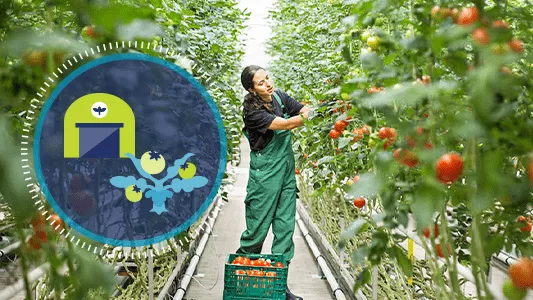As the name suggests, a GS1 DataBar Expanded is longer than the shorter omnidirectional barcodes and has more capabilities. It has a capacity of up to 74 numeric or 41 alphanumeric characters, with the capability for attributes like serial numbers, batch/lot numbers, dates, and more. The additional attributes allow a manufacturer, transport provider, or merchant to track individual items through the supply chain, including the POS. The expanded barcode can still be read omnidirectionally.
-
Barcodes are everywhere in our world. From everyday products at the supermarket to location identification throughout the supply chain to healthcare services, barcodes are used across a wide variety of industries. Because barcodes serve diverse purposes across various industries, there are many different kinds. A GS1 DataBar® is one of many solutions for data transmission and retention that allows businesses to share information more efficiently and accurately.
Of the many types of barcodes, a GS1 DataBar offers solutions to multiple challenges across the supply chain. With several available structures, some GS1 DataBar options can hold more data than more common barcodes, while other types are smaller, for use on products of varying sizes.
-
Related Topics
Types of DataBar Barcodes
The GS1 DataBar has seven different structures that follow the same overall GS1 DataBar symbology. The barcode is designed to be easily read by a scanner to provide only the product identifier or share additional information in unique attributes. Each DataBar serves a different purpose and allows merchants to share information quickly when and where it’s needed. The seven DataBar barcodes include:
Omnidirectional
The GS1 DataBar Omnidirectional is structured like a traditional linear barcode so scanners can read the code the same way. The barcode holds a 14-digit numeric code that identifies the product. This embedded code can be a Global Trade Item Number® (GTIN®). The GTIN can be used at the point-of-sale (POS) to streamline sales by quickly accessing the pricing and product database.
Stacked Omnidirectional
The GS1 DataBar Stacked Omnidirectional offers flexibility for use on small products. Often, a stacked omnidirectional DataBar will be used at the POS on produce stickers, like bananas or apples, because it can be printed much smaller than a UPC used on larger items. The stacked omnidirectional barcode is arranged in two layers with the same product identifier, the GTIN, used in UPCs and other GS1 DataBars. This arrangement allows the stacked barcode to be compressed into a smaller space than the single-layered barcode.
Expanded
Expanded Stacked
The GS1 DataBar Expanded Stacked is the condensed version of the expanded barcode. It has the capabilities and capacity as its expanded counterpart. Rather than a single linear barcode, the expanded stacked barcode can be two or more layers of code that can be read omnidirectionally. This barcode can be used where there isn’t enough space for the expanded DataBar. This type of GS1 DataBar is used on fresh foods and coupons.
Additional DataBars
In addition to the previously mentioned DataBars, there are three barcodes that cannot be used at POS. The DataBar stacked, limited, and truncated all have the capacity for a 14-digit numeric GTIN. These barcodes cannot be read omnidirectionally and are used in situations where such scanning, like at POS (point-of-sale) isn’t required. They’re also ideal for use when packaging space is limited and have been previously used in healthcare applications.

DataBar vs. EAN/UPC
Most of the GS1 DataBar barcode types, like an European Article Number (EAN) or UPC, can be used at POS. Visually, the omnidirectional DataBar looks similar to an EAN and UPC. However, the stacked and expanded DataBars are present much differently than the EAN and UPC, as they will be much longer horizontally or stacked two or more high. GS1 DataBar was originally called the reduced space symbology because the GTIN-only versions are smaller than the EAN or UPC. The smaller size was ideal for hard-to-mark items, like loose produce. The expanded GS1 DataBar options have additional capabilities that are not available from the others. EANs and UPCs are limited to 13- and 12-numeric-digit GTINs respectively, but the GS1 DataBar expanded and expanded stacked have capacity for data beyond only the GTIN, like weight tracking, serial numbers, etc.
DataBar Barcode Uses
While not every DataBar can be used at POS, they all hold essential product identifiers and attributes important for tracking through the supply chain. Each DataBar is structured for different uses, enabling each party to identify products efficiently and accurately with a single scan. GS1 DataBar is most commonly used on fresh foods, loose produce, and manufacturer coupons.
Use the GS1 DataBar Barcode Generator
You can create unique DataBar barcodes for each of your products using a DataBar Barcode Generator from one of our trusted GS1 trusted solution partners. Licensing a GS1 Company Prefix or a single GTIN from GS1 US ensures that your barcodes are globally unique.
Get Your UPC Barcodes from GS1 US
Scale Up With a GS1 Company Prefix
A GS1 Company Prefix allows businesses to get multiple barcodes at a single time, as well as identify locations, mixed cases, create coupons, and create higher levels of packaging like a case or pallet.
Start Small With a GS1 US GTIN
Barcodes issued by GS1 US uniquely identify a single retail product online and in retail stores around the world. If you have only a few products that need barcodes, this might be the most cost-effective option for your company.
Recommended Resources
Here are additional resources that might interest you:


